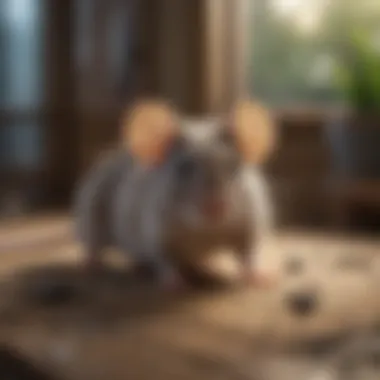Discover Natural Methods to Safely Eliminate Mice Without Chemicals


Animal Species Profile
When it comes to dealing with mouse infestations in your home, it is essential to understand the nature and behavior of these unwelcome rodents. Mice, known for their small size and scurrying habits, are highly adaptable creatures with keen senses that aid in their survival. These pests are capable of squeezing through tiny openings and quickly multiplying, making them a challenging nuisance to eradicate completely.
Conservation & Wildlife Efforts
While mice might not be the focus of wildlife conservation efforts due to their status as pests, it is crucial to acknowledge the potential implications of using harmful chemicals in trying to control their populations. Balancing effective pest management with ecological sustainability remains a delicate challenge. Therefore, exploring natural and eco-friendly methods to eliminate mice is not only beneficial for your home but also aligns with broader environmental conservation goals.
Animal Behavior & Psychology
Understanding mouse behavior is key to implementing effective pest control strategies. Mice communicate through various means, including ultrasonic vocalizations and pheromones, to coordinate activities such as foraging and reproduction. Their ability to quickly adapt to changing environments and outsmart traditional traps highlights their remarkable problem-solving skills. Moreover, exploring the emotional intelligence and social dynamics within mouse colonies can offer insights into more humane approaches to managing infestations.
Pet Care & Tips
For pet owners, especially those with cats or dogs, navigating a mouse infestation can be challenging. It is crucial to ensure that pets do not come into contact with harmful substances used to eliminate mice, as this can pose health risks. Choosing pet-safe methods to control mice in your home is essential to safeguard the well-being of both your furry companions and the environment. By implementing preventative measures and creating an inhospitable environment for mice, pet owners can effectively deter these pests without compromising their pets' safety.
Introduction
In the realm of household issues, mouse infestations pose a significant concern, prompting the necessity for effective and natural methods to eradicate these unwelcome guests. This comprehensive guide meticulously navigates through the intricacies of combatting mice infestations without resorting to harmful chemicals, offering insights into humane and eco-friendly practices that align with the conscientious homeowner's values.
Understanding the Issue
Risks Associated with Mouse Infestations
Delving into the risks linked with mouse infestations reveals a myriad of potential hazards that extend beyond mere nuisance. These infestations can lead to health risks, property damage, and sanitation concerns. The ubiquitous nature of these risks makes addressing mouse infestations a priority for maintaining a safe and hygienic living environment. By understanding these inherent dangers, individuals are motivated to seek natural and non-toxic solutions to mitigate the threats posed by mouse presence in households.
Importance of Addressing the Problem
The importance of addressing mouse infestations cannot be overstated, as these issues can escalate swiftly, resulting in widespread contamination and structural damage. By proactively tackling the problem, homeowners can prevent the escalation of infestations, safeguarding their households from the adverse effects of unchecked rodent presence. The emphasis on early intervention underscores the significance of implementing natural methods to combat mouse infestations effectively, thereby fostering a safe and healthy living environment.
Benefits of Natural Solutions
Safety for Pets and Children
Prioritizing the safety of pets and children is a paramount consideration when addressing mouse infestations, as traditional pest control methods often involve toxic substances harmful to curious animals and young ones. Natural solutions provide a safe alternative, ensuring that the household remains free from harmful chemicals that could endanger beloved family members. The inherent safety of natural remedies aligns with the responsible pet ownership and parenting ethos, making them an appealing choice for households seeking an effective yet safe approach to pest control.
Environmentally-Friendly Practices
In an era where environmental sustainability is a pressing concern, opting for environmentally-friendly practices in pest control is a conscientious choice that resonates with those advocating for eco-conscious living. Natural solutions prioritize the well-being of not only the household occupants but also the environment at large, steering clear of chemical pollutants that may harm ecosystems. By embracing eco-friendly practices in mouse elimination, homeowners contribute to a greener and healthier planet, aligning their pest control efforts with broader sustainability initiatives.
Preventative Measures


Preventative measures play a vital role in addressing mouse infestations without resorting to harmful chemicals. By implementing proactive steps, homeowners can create a hostile environment for mice, deterring them from entering living spaces. It is crucial to focus on sealing entry points and maintaining cleanliness to prevent mice from thriving. These measures not only help in avoiding infestations but also promote a safe and healthy living environment for residents by minimizing the risks associated with rodents.
Sealing Entry Points
Identifying common entryways is a crucial aspect of mouse prevention. By locating potential openings through which mice can enter the home, residents can take targeted actions to secure these vulnerable points. Common entryways such as gaps around doors and windows, utility penetrations, and vents are prime targets for mice seeking shelter. Ensuring these openings are properly sealed with durable materials can effectively block mouse access, significantly reducing the likelihood of infestations. Despite the challenges of identifying all potential entry points, a thorough inspection combined with strategic sealing efforts can immensely enhance the security of a home against rodent intruders.
Sealing Cracks and Gaps
Sealing cracks and gaps is a fundamental step in reinforcing a home's defenses against mice. Mice can exploit even the tiniest openings to gain entry, making it imperative to seal any visible cracks or gaps in walls, floors, and foundations. By using appropriate sealants or fillers, homeowners can eliminate potential entry points that might otherwise go unnoticed. While the process of sealing cracks and gaps requires attention to detail and thorough execution, the benefits of this preventive measure far outweigh the efforts involved. Effective sealing not only deters mice but also contributes to energy efficiency and structural integrity, making it a valuable practice in safeguarding homes against pest incursions.
Maintaining Cleanliness
In addition to sealing entry points, maintaining cleanliness is key to reducing factors that attract and sustain mouse populations in residential settings. The proper storage of food items in secure containers prevents mice from accessing potential food sources, limiting their incentive to remain indoors. Decluttering living spaces removes hiding spots and nesting materials that mice rely on for shelter, disrupting their ability to establish stable populations. By prioritizing cleanliness in household areas susceptible to rodent activity, individuals can create an inhospitable environment for mice, reducing the likelihood of infestations and promoting overall hygiene.
Proper Food Storage
Proper food storage entails storing consumables in airtight containers to prevent mice from contaminating or accessing them. By minimizing food availability to rodents, homeowners diminish the attractiveness of their residence as a potential feeding ground for unwanted visitors. Adhering to organized food storage practices not only inhibits mice from foraging indoors but also safeguards the health and well-being of household members by preventing foodborne illnesses and damage.
Decluttering Spaces
Decluttering spaces involves eliminating unnecessary items and maintaining a tidy living environment to discourage mouse habitation. By reducing clutter, individuals remove potential nesting materials and hiding spots that mice utilize for breeding and shelter, disrupting their capability to establish colonies within a residence. Decluttering promotes better air quality, reduces health hazards, and enhances the overall aesthetics and functionality of living spaces, making it an essential component of mouse prevention strategies. Prioritizing decluttering efforts contributes to a harmonious living environment free from the disruptions and health risks associated with rodent infestations.
Natural Deterrents
In the pursuit of addressing mouse infestations naturally, the section of Natural Deterrents stands out as pivotal within this informative article. Natural deterrents play a crucial role in deterring mice from infiltrating homes without resorting to harmful chemicals, aligning perfectly with the theme of humane and eco-friendly pest control. By focusing on elements such as essential oils and herbal repellents, this section offers a sustainable approach to resolving mouse infestations while prioritizing the safety of pets and children and promoting environmental conservation.
Essential Oils
Peppermint Oil
Diving into the specifics of Peppermint Oil reveals its significant contribution to the overarching goal of resolving mouse infestations naturally. The key characteristic of Peppermint Oil lies in its potent scent, which functions as a powerful mouse deterrent. Widely recognized for its effectiveness, Peppermint Oil emerges as a popular choice due to its natural properties that repel mice. One unique feature of Peppermint Oil is its non-toxic nature, making it a safe yet efficient option for addressing mouse-related concerns. While its advantages include a pleasant aroma and easy application, a potential disadvantage is the need for frequent reapplication to maintain its repellent effect.
Eucalyptus Oil
The inclusion of Eucalyptus Oil in the discussion further enhances the range of natural deterrent options available for combatting mouse infestations. Eucalyptus Oil is distinguished by its strong aroma, which serves as a deterrent against mice seeking to invade living spaces. Its key characteristic lies in the eucalyptol compound, renowned for its pest-repelling properties, making Eucalyptus Oil a beneficial choice for this article. A unique feature of Eucalyptus Oil is its versatility, not only in deterring mice but also in promoting relaxation and alleviating congestion. While its advantages encompass efficacy and natural origin, potential disadvantages may include sensitivity in some individuals and the need for careful storage to maintain potency.
Herbal Repellents
Lavender
Delving into Lavender as a herbal repellent sheds light on its valuable contributions to combatting mouse infestations naturally. The key characteristic of Lavender stems from its soothing fragrance, which doubles as a potent repellent for mice. Lavender emerges as a popular choice due to its pleasant aroma and versatile applications in pest control. One unique feature of Lavender is its calming properties, enhancing the living environment while deterring unwanted rodent guests. Advantages of using Lavender include its non-toxic nature and effectiveness in repelling mice, though potential drawbacks may involve the need for regular replenishment to maintain its potency.


Rosemary
Exploring the role of Rosemary in this context amplifies the array of herbal repellents available for addressing mouse infestations naturally. Rosemary's key characteristic lies in its strong scent, acting as a formidable barrier against mice seeking entry into homes. Its popularity in pest control solutions is attributed to its aromatic properties that effectively repel rodents. A unique feature of Rosemary is its versatility, not only in deterring mice but also in culinary and medicinal applications, adding to its appeal for combating mouse infestations. Advantages of using Rosemary include its natural composition and multifaceted benefits, yet potential disadvantages may involve allergic reactions in sensitive individuals and considerations regarding proper dosage for optimal effectiveness.
Physical Barriers
In this exploratory piece on natural ways to eliminate mice, an emphasis is placed on the crucial role of implementing physical barriers. Physical Barriers are vital components in protecting spaces from rodent intrusions due to their ability to block off common entry points that opportunistic mice may exploit. By sealing off openings such as cracks and gaps in walls, windows, and doors, households create a robust defense system against these sneaky creatures. The significance of Physical Barriers lies in their proactive approach towards prevention, offering long-term solutions with minimal environmental impact. Integrating Physical Barriers into the pest management strategy ensures a sustainable and eco-friendly method of deterring mice while safeguarding the welfare of both pets and children.
Ultrasonic Devices
How They Work
Delving into the mechanics of Ultrasonic Devices sheds light on their operational functionality in deterring mice infestations. Ultrasonic Devices emit high-frequency sound waves that are disruptive to rodents, creating a hostile environment that drives them away. This non-invasive method is a preferred choice for many households due to its non-toxic nature and pet-friendly attributes. The innovative feature of Ultrasonic Devices lies in their ability to target mice without posing any harm to other household members, making them a popular and effective option for natural pest control strategies. While the unique characteristic of Ultrasonic Devices lies in their ability to operate silently, their efficacy in repelling rodents may vary depending on factors such as room size and insulation levels.
Effectiveness
Assessing the effectiveness of Ultrasonic Devices unveils their impact in combatting mouse infestations. The key strength of Ultrasonic Devices lies in their ability to target pests in hard-to-reach areas, making them an efficient tool in controlling rodent populations. The choice to integrate Ultrasonic Devices in pest management strategies stems from their non-invasive nature and zero chemical use, aligning with eco-friendly practices. However, limitations exist in the effectiveness of Ultrasonic Devices, especially in large and highly cluttered spaces where sound waves may be obstructed, reducing their overall impact. Understanding the advantages and disadvantages of Ultrasonic Devices is essential in optimizing their use within the context of this article's focus on natural solutions for eliminating mice.
Mesh Screens
Installing and Utilizing
Exploring the importance of Mesh Screens delves into their practical applications in preventing rodent intrusions. Installing Mesh Screens on windows and vents acts as a physical barrier that blocks mice from entering living spaces while promoting adequate airflow. The key characteristic of Mesh Screens lies in their durability and low maintenance requirements, providing a long-term solution for safeguarding homes against rodent infestations. However, Mesh Screens may pose challenges in terms of installation complexity and initial cost, requiring careful consideration before implementation. Despite these potential drawbacks, Mesh Screens offer a reliable and environmentally friendly approach to pest control, aligning with the broader theme of natural solutions advocated in this article.
Trapping Methods
Trapping methods play a crucial role in the comprehensive guide of natural ways to eliminate mice. They serve as effective means of rodent control without resorting to harmful chemicals. Traps are essential components of a humane and eco-friendly approach to managing mouse infestations. By understanding the specific elements of trapping methods, individuals can successfully address mouse issues in their homes. These methods offer benefits such as targeted removal of mice while safeguarding the well-being of pets and children. Additionally, trapping methods consider the environment, promoting sustainable pest control practices for long-term efficacy.
Live Traps
Live traps are a prominent feature in the realm of trapping methods due to their humane nature. Best practices associated with live traps emphasize the importance of non-lethal techniques in capturing mice. The key characteristic of live traps lies in their ability to catch rodents without causing harm, allowing for safe relocation of captured mice. This approach is favored for its ethical considerations, making it a popular choice for those seeking to address mouse infestations in a compassionate manner. However, the unique feature of live traps, although humane, may require individuals to release captured mice at a distance from their homes, posing potential challenges in preventing reentry.
Release Techniques
When employing live traps, understanding release techniques is vital for ensuring successful rodent management. Effective release techniques involve transporting captured mice to suitable environments far from residential areas. The key characteristic of release techniques lies in promoting the safe and distant release of mice, minimizing the likelihood of their return to homes. This strategy is beneficial for maintaining a balance between humane pest control and prevention of reinfestation. However, the unique feature of release techniques may require individuals to actively monitor and secure potential entry points post-release, adding a level of vigilance to the trapping process.
Homemade Trap Solutions
Homemade trap solutions offer a DIY approach to mouse control, providing cost-effective alternatives to commercial traps. When considering bucket traps, their specific aspect involves leveraging simple materials such as buckets, ramps, and bait to attract and capture mice. The key characteristic of bucket traps is their ease of construction and deployment, making them a convenient choice for individuals aiming to address mouse infestations promptly. However, the unique feature of bucket traps, while effective, may require regular monitoring and resetting to ensure ongoing rodent capture.
Rolling Log Trap


In the realm of homemade trap solutions, the rolling log trap stands out for its ingenious design and functionality. This trap capitalizes on the natural behavior of mice to seek shelter under rolling structures, leading to their capture. The key characteristic of the rolling log trap is its ability to entrap rodents without causing harm, aligning with humane pest control practices. This feature makes it a popular choice among individuals seeking non-toxic and eco-friendly trapping methods. However, the unique feature of the rolling log trap, although effective, requires placement in strategic locations and periodic checks to maintain its trapping efficiency.
Professional Assistance
Professional Assistance plays a crucial role when dealing with mouse infestations. Expert help ensures a comprehensive and effective approach to eliminate mice from your home environment. Professionals offer specialized knowledge and skills that are essential in developing customized solutions tailored to your specific infestation.
They utilize advanced tools and techniques to identify the extent of the infestation, locate entry points, and strategically place traps or deterrents. Professional assistance guarantees a humane and eco-friendly process, minimizing harm to both mice and the environment. Moreover, their interventions comply with local regulations, ensuring the legality and safety of the methods employed.
Professional exterminators provide ongoing support and follow-up services to prevent future infestations, offering peace of mind to homeowners. Their expertise in pest control allows for a quicker resolution, reducing the risks associated with prolonged exposure to mice and potential property damage.
When to Seek Help
Signs of Severe Infestations
When your home shows persistent signs of mouse activity such as droppings, gnaw marks on furniture or food packaging, or sightings of mice during daylight hours, it indicates a severe infestation. These signs point to a large and established mouse population within your residence, posing health risks and property damage.
Seeking professional help becomes imperative at this stage to address the infestation comprehensively. Trained pest control specialists can assess the severity of the situation, implement targeted solutions, and monitor the effectiveness of the treatment. Their intervention is crucial in mitigating the health hazards associated with mouse presence and safeguarding the structural integrity of your property.
Understanding Local Regulations
Understanding Local Regulations is vital when seeking professional assistance for mouse infestations. Different regions may have specific laws or guidelines regarding pest control methods and the treatment of animals. Compliance with these regulations is essential to avoid legal repercussions and ensure ethical pest management practices.
By adhering to local regulations, pest control services can operate within legal boundaries while prioritizing the safety of both humans and wildlife. This alignment with legal frameworks promotes responsible pest management and upholds a harmonious coexistence between households and their surrounding environment.
Choosing Humane Pest Control Services
Researching Options
Researching Options is a critical step in selecting humane pest control services. By exploring different companies' backgrounds, services offered, and customer reviews, homeowners can make informed decisions. Consider factors such as the company's reputation, experience in dealing with mouse infestations, and use of eco-friendly practices.
Choose a pest control provider that emphasizes humane treatment of animals and follows sustainable pest management practices. Conduct thorough research to ensure the company's methods align with your values and commitment to ethical pest control.
Ensuring Ethical Practices
Ensuring Ethical Practices by pest control services guarantees a compassionate and environmentally conscious approach to mice infestations. Ethical practices encompass utilizing non-toxic deterrents, implementing preventative measures, and considering the well-being of both mice and other wildlife.
By partnering with an ethical pest control service, homeowners contribute to preserving biodiversity and supporting eco-friendly pest management solutions. Ethical practices promote a harmonious balance between human habitats and natural ecosystems, fostering sustainable living practices.
Conclusion
Embracing Eco-Friendly Solutions
Sustainable Practices for Long-Term Results
Delving into the specifics of sustainable practices for achieving long-term results in mouse control, it becomes apparent that eco-friendly solutions provide a holistic approach towards pest management. The key characteristic of sustainable practices lies in their ability to address not just the immediate issue of mouse infestations but to establish a lasting barrier against future intrusions. By incorporating methods that prioritize prevention alongside elimination, such practices contribute to a more harmonious coexistence with surrounding wildlife and ecosystems.
Moreover, one of the standout features of sustainable practices is their emphasis on using non-toxic and biodegradable materials, reducing the overall environmental impact. This not only ensures the safety of non-target species but also aligns with the ethos of responsible stewardship of the natural world. While the advantages of sustainable practices are evident in their efficacy in controlling mouse populations, it is essential to note that their long-term benefits extend beyond mere pest eradication, fostering a more sustainable living environment for all inhabitants of the home.







